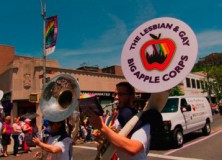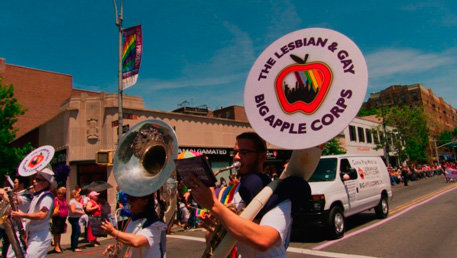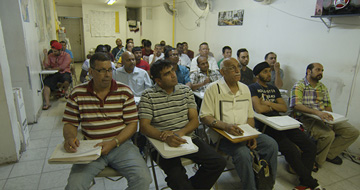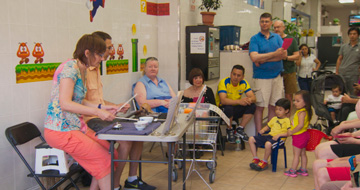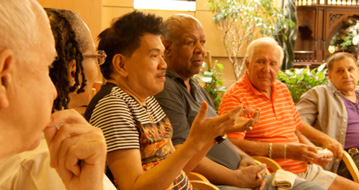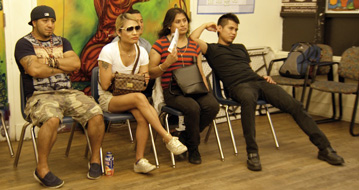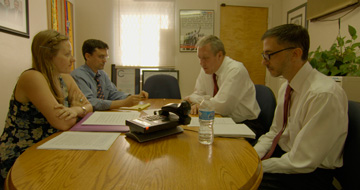* 53rd New York Film Festival
All of this will go
by Fabio Andrade
“And darling, it’s not
Easy to spot
But all of this will go
Darling, sometimes
These things take time
But all of this will go”
All of This Will Go, Guided by Voices
In recent years, Frederick Wiseman’s documentaries have been defined first and foremost by a very precise sense of place, with clearly established spatial boundaries that are often exposed in the titles of the films. What results from this voluntary enclosure usually gravitates between two opposite poles. In one extreme, there are movies that seize this limitation of space as a chance to focus on the nature of the social and human procedures that take place within them. The place is then defined by this activity, and Wiseman’s task is to unfold the many layers of the action staged in that space, so that he can find the ontological specificity of such action. The place is, in this case, a dispositif, a stage where this activity happens, and the setting, like a laboratory, allows his camera to shed light on the activity itself. It’s the case of La Danse (2009), Boxing Gym (2010), Crazy Horse and National Gallery (2014). In the polar opposites are the movies that use the multiplicity of human experiences to create a form of tapestry, in order to determine and visualize the nature of this space. Instead of starting from the spatial confinement to investigate in 360 degrees the wholeness of a certain activity, it’s the sum of loosely connected actions and engagements that results in a complex image of the place itself. That’s the case of At Berkeley (2013) and of this brand new In Jackson Heights.
The result of this specific strategy is apparently closer to a more traditional experience of direct cinema, where the spectator is carefully infused with patience through the pregnant nature of the events themselves, until the pieces fall into place and an overarching sense is revealed. In this case, Wiseman quietly observes the daily life of Jackson Heights, a neighborhood enclaved in the Queens borough, just on the fringe of the latest trendy neighborhoods in the city. The variety of the presented situations seems to be guided by a motto we hear at an LGBT group meeting that the movie shows in the first minutes of projection: “Jackson Heights is the most diverse community in the whole world”. And for a very long time, this is what we get. Instead of starting with a definitive principle that will be narrowed down and specified throughout the film, Jackson Heights is defined through expansion, humanized by all the different colors, textures, accents and rituals, from the aniline stained flowers to the local chicken slaughterhouse. These scattered slices of life create this patchwork-like portrait of the place, and this experience – which never reeks of tourism, seeking for the contradictions of expatriate authenticity, yes, but not for exoticism – is, in itself, a rewarding one.
But there’s a certain eeriness permeating all these different episodes, a sense of danger that spreads from the local businesses to the political gatherings, from the World Cup matches to the LGBT parade, that seems strongly tied to the history of the neighborhood. The movie seems to be fueled by a subtle, yet developing uneasiness that immediately recalls the second part of another recent observational masterpiece: Wang Bing’s West of the Tracks (2002). In the second block of the epic narrative of Shenyang, Wang Bing spends a couple of hours simply following a tightly-knit group of teenagers, who spend most of their time roaming around the neighborhood. We learn their names, memorize their voices and witness the way they interact, all for no apparent reason. It is only after we’re already very much familiar with those people and how their lives are defined by being together that we learn that they’re all going to be removed from that neighborhood, which is going to be torn down, and sent to different parts of the province. That relationship we just grew fond of is just about to end, interrupted by the merciless historical process. A similar sense of anticipated mourning takes over In Jackson Heights, first presented rather casually at the beginning of the film, but that finds proper weight once we’re given the chance to spend more time in the neighborhood: the BID (Business Improvement District) is trying to pass new regulations for the neighborhood zones, which will eventually take most small business owners out of business, and force the people who live in the neighborhood to move to other areas, breaking the connections they’ve established with the place and their neighbors through the years.
In Jackson Heights quickly moves from an observational documentary to a thriller, in a sense that Chantal Akerman’s extraordinary Jeanne Dielman, 23, Quai du Commerce, 1080, Bruxelles is also a thriller: an anxious wait for this unknown, yet imminent catastrophe. What makes the movie so much more than a conservative lament is, again, directly connected to the choice of space. First, because of Jackson Heights’ multiple nature, with its braiding of latinos, jews, muslims, african-americans, old school families and new world classes: this is a neighborhood founded on variety, and no image can be more antithetical to that than a GAP taking over an entire block’s worth of small shops. Second, because unlike many other areas of New York, Jackson Heights is not quite gentrified yet; it’s next in line, for sure, and the surrounding neighborhoods announce its fate in big, bold letters, but this feeling of “not yet” is enough to trade reactionary (albeit fair) romanticism for actual activism.
The many gatherings the film witnesses, of all the different minority groups that are trying to overcome their feeble weakness by basically sticking together, is not only another representation of the piecemeal nature of the community, but also a bold reminder of the foundations of representative democracy and of the constitution of any modern country (despite the often old political inclinations). The latino business owners are seen as equals to the neighborhood’s official representative, who is seen as an equal to mayor De Blasio, as if to say that the powers that be are also dependent on and responsible for the weak (the entire episode of the city ID brings that to a practical foreground). Suit and tie, or with shoes untied, they’re all filmed with the same interest and dignity, as they’re all equal parts in the formation of the space in question. The abstract idea of community is actualized by the practice of communion, of citizenship, of taking part in, and the neighborhood is reestablished as a Greek square: a place where ideas, fears and desires are voiced and shared, as vibrations that can and will affect the community surrounding them.
What’s at stake, then, is not only a small barber shop, an aging clientele, or an authentic New York neighborhood; what’s at stake is democracy itself. And democracy is more by being, at its core, a sum of small parts, and so is the film. And it’s precisely by seeing them as small, as something beautiful and alive enough to be cherished and nurtured, that they’re allowed to expand and bloom into a sum that’s larger, more meaningful and more change-provoking (from the bottom up) than any of its parts. In Jackson Heights animates all these reflections without ever announcing them (that’s the strategy of the enemy, the strategy of the BID and of Gap, and Wiseman would never speak their language), through an observational and always surprisingly allegorical instinct (every twig is a microcosm, when seen through Wiseman’s lenses) that only gets clearer, more patient, more focused and more remarkably poignant and precise with each new film.
